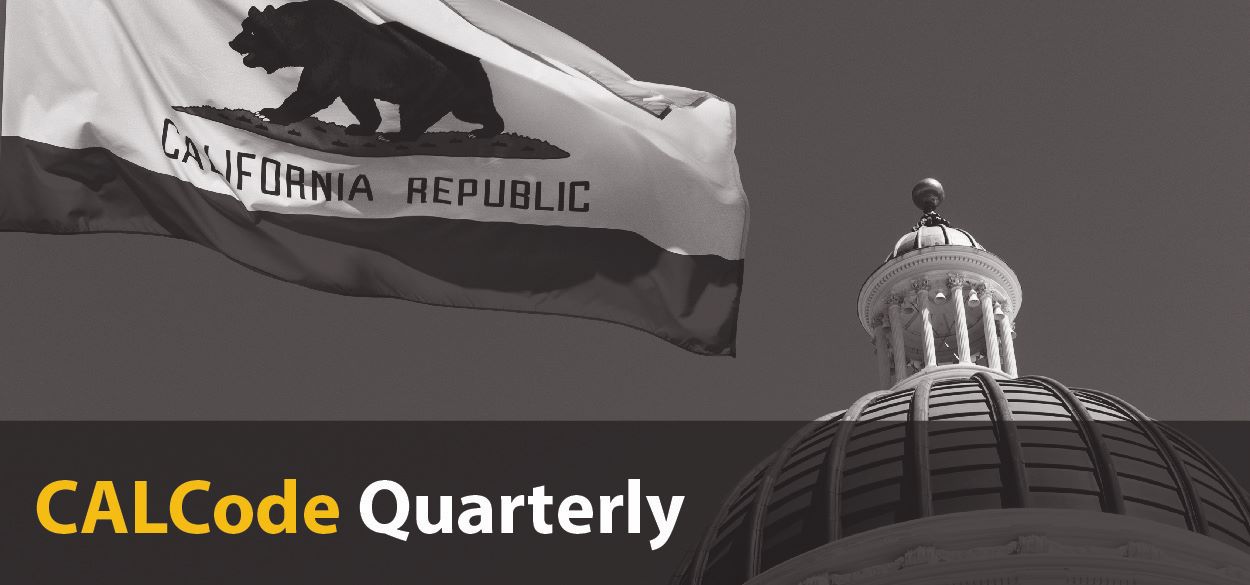CALCode Quarterly - Fall 2021

Executive Director Message
The California Building Standards Commission (CBSC) team has been very busy during 2021 administrating the 40-plus Title 24 rulemaking packages submitted during the 2021 Triennial Code Adoption Cycle. This fall, the CBSC team is wrapping up the public comment phase of this rulemaking cycle that will result in the publication of the 2022 California Building Standards Code, Title 24 of the California Code of Regulations. You may view the progress of this cycle on our 2021 Triennial Code Adoption Cycle rulemaking webpage.
The next phase is for the state agencies to submit their final rulemaking packages to CBSC staff. Staff review and prepare the meeting materials that will be made available on our website, and are then reviewed by the commissioners for final action at public meetings in December and January. See our Cycle Status article below for more about this phase in the development of the 2022 edition of Title 24.
CBSC recently welcomed two new staff members. Carol Hagler, an Associate Governmental Program Analyst, is working on website development, document accessibility and legislation analysis, and Michael Novang is our new Office Technician. See our Staff Spotlight for more about our new teammates.
Staff members are also working on many resources to assist code users when the new edition of Title 24 is published. Since we frequently receive inquiries asking, “What’s new in the codes?” we are working to develop a 2022 Title 24 Code Updates publication. We thought it would be beneficial to know how you, the code user, would prefer to access this document. Please take a moment to respond to our poll on the left side of the page to help us craft a resource that is useful and meets your needs. We plan to issue CBSC’s 2022 Title 24 Code Updates between the publication and effective dates of the 2022 edition of Title 24. Other publications of interest to the public and regulated communities are shared on the Resources page of CBSC’s website.
The National Fire Protection Association (NFPA) is the author and publisher of the National Electrical Code (NEC), which is the model code on which the California Electrical Code (Part 3 of Title 24) is based. NFPA works diligently with stakeholders across the nation to develop appropriate and effective building standards in the NEC, which are then adopted for use in California with additions and amendments for California’s special circumstances. In this edition of CALCode Quarterly, we share an NFPA article regarding their code development process and public participation.
Recently, I have had the pleasure of attending events with design professionals interested in the activities of CBSC, as highlighted in the Education and Outreach component of this newsletter. If you would like CBSC to present in person or virtually at your meeting or event, please contact our Education and Outreach Coordinator at cbsctraining@dgs.ca.gov.
Even though the current code cycle is still wrapping up, CBSC staff and other state agencies are already planning for the next code cycle—the 2022 Intervening Code Adoption Cycle—that will produce the 2022 supplement, effective July 1, 2024. Late winter and early spring, watch for meeting notices for the coordinating council meeting or pre-cycle code workshops. You can read more about the coordinating council on our About Us webpage. You can follow CBSC activities on the Rulemaking page of the website, or by signing up for our mailing list using the link on our Contact page.
Until next year, I wish you a safe, healthy and happy remainder of 2021.
Feature Articles
Be A Part of the Process: NFPA Codes and Standards in the Making
By Ray Bizal
Director, Regional Operations
NFPA
Codes and standards promulgated by the National Fire Protection Association® (NFPA®) are an integral part of California’s extensive building, electrical, fire and life safety network. These same NFPA standards used by the enforcement community are developed through an open-consensus process in which anyone (except NFPA staff) can participate. NFPA often receives questions about how this time-tested process works, so here is a broad overview of how NFPA standards are developed.
The NFPA standards development process
By way of background, NFPA facilitates the development of more than 300 codes and standards used worldwide that cover myriad aspects of building, electrical, fire, and life safety through a consensus process that is accredited by the American National Standards Institute. Each document is revised every three to five years, in a four-part process: First Draft; Second Draft, Membership Action, and Appeals/Issuance:
First Draft: Each revision cycle opens with a call for Public Input. During this phase, the public can suggest changes in text to the current edition. All public input received is then discussed by the appropriate Technical Committee during an open meeting, where they take action on each suggested revision. Once their decisions are balloted, the First Draft Report is published. This First Draft Report outlines the technical committee’s actions and responses to all public input and provides a draft of the next edition based on the accepted revisions.
Second Draft: Next, the Public Comment Period seeks review and suggested changes to the revisions provided in the first draft. After the committee’s review and action on the public comments, their recommended text changes and responses to all public comments are published in the Second Draft Report for additional public review.
Membership Action: At the NFPA Technical Meeting each June, there is an opportunity to challenge a proposed change to a standard through action by the NFPA membership. This is done in advance of the meeting by filing a Notice of Intent to Make a Motion (NITMAM) so that it is known which issues will be debated at the meeting. Anyone may attend the meeting and debate motions. Then the NFPA membership in attendance votes to either support the debated motion or move forward with the technical committee’s recommended second draft text as presented.
Appeals/Issuance: The outcome from the first and second drafts and the membership actions are presented to the NFPA Standards Council. During this time, anyone may file an appeal with the Standards Council that will decide, based on all evidence, whether to issue the standard or return it to the technical committee for further revision.
Once through this four-part process, the next editions of the documents are issued. It is important to note, however, that NFPA staff cannot submit revisions, nor can they vote on revisions; the staff simply facilitates the process.
Code document resources
Each document has its own document information page, a valuable resource for professionals looking to get involved in the process or to learn more about a particular code or standard. Critical information is available for each through seven tabs:
Current Edition: Free access to the document, archived revision information on the revisions, Tentative Interim Amendments (TIA), errata, and other information relative to each edition.
Next Edition: Submit public input or public comments through this portal when documents are in their revisions cycle. Monitor activities of the development of the next edition.
Technical Committee: Technical Committee information for each document, and a portal to submit applications to join committees.
Ask a Technical Question: Code officials, Authorities Having Jurisdiction (AHJs) and NFPA members use this portal to ask technical questions about the document at no cost.
News: Articles, news, and reports related to subject of the document.
Purchase Products and Training: Products and training related to the subject of the document.
Related Products: Additional products are posted related to the subject of the document.
Access to NFPA information and knowledge
Code enforcers often suffer under extensive workloads. A new digital platform, NFPA LiNK™, has been helping professionals and practitioners who work with the codes be more effective and efficient on the job while helping them increase safety. A subscription-based application, NFPA LiNK delivers codes and standards, expert commentary and supporting content, and allows users to easily navigate and understand code requirements based on real-life situations. Its newest feature allows workers to store content for offline viewing, curate content, bookmark, add notes, share, and collaborate. For professionals enforcing the codes, this is especially helpful when working on multiple jobsites each day.
Every day the California code enforcement community diligently works to ensure public safety and help prevent loss and injuries from fire, electrical, and other hazards. Using codes and standards daily, you are in a prime position to help determine the content and submit revisions that can only make these documents better. NFPA encourages everyone in the California enforcement community to share their experience, best practices, thoughts, and ideas in the codes and standards development process. As a full, open consensus-based process, your voice will be heard. We look forward to hearing from you.
Mr. Bizal can be reached at rbizal@nfpa.org.
Preparing Proposals for Commission Review
A review of CBSC’s rulemaking website will show that we are nearing the end of the public comment periods for the 2021 Triennial Code Adoption Cycle. The next phase of the cycle will be to prepare all the proposed new regulations and California amendments for review and action by the commissioners.
During the public comment phase of a code adoption cycle, each agency must review each public comment related to their proposals. When a state agency modifies their proposal as a result of a public comment, an additional public comment period must be held. After all public comment periods conclude, the agency can finalize their rulemaking documents. Each agency’s response to all public comments is documented and included with their final rulemaking package that is presented to the commissioners at a public meeting for approval and adoption for publication in Title 24.
The following is a list of the final rulemaking documents posted to CBSC’s website.
Final Express Terms – New, repealed or amended regulatory language shown in strike out and underline.
Final Statement of Reasons – Explains why the regulations are being proposed, and shares code advisory committee recommendations and public comments received, and the agency’s responses.
Updated Informative Digest – Provides a summary of existing laws and regulations, and the effect of the proposed codes on the regulated community.
Commission Action Matrix (CAM) – A table that shows the progress of each proposed code section through the cycle, from Code Advisory Committee to public comments. CAMs are presented in three different colors for a commission meeting: GREEN is for items that were not challenged or controversial during the public comment phase, YELLOW is for items that received public comments challenging an element or elements of the proposal, and SALMON is for items that were withdrawn and are no longer to be considered by CBSC.
During the pandemic, CBSC was able to transition from producing hard copy binders for the commissioners to an electronic document sharing platform. This has reduced staff time and expense required for printing, assembling and mailing the binders to the commissioners throughout the state.
Currently, CBSC public meetings are taking place on a virtual platform that provides public participation, just like at an in-person meeting with a physical meeting location. At least 15 days before the scheduled meeting date, CBSC issues an agenda notice and posts on its website meeting materials associated with the agenda items that will be heard during the meeting. Interested parties can sign up to receive email notifications of CBSC activities using the link on the Contact tab of CBSC’s website.
During the public meetings, the state agency representatives present their rulemaking proposals, the commissioners deliberate, members of the public are invited to comment, and then the commission takes action to approve, approve as amended, return for further study or disapprove the code proposals. All approved or approved as amended regulations are filed with the Secretary of State. Then, CBSC staff will work with the publishers to ensure the 2022 edition of Title 24 is published on or before July 1, 2022. The 2022 edition will be effective January 1, 2023.
For more information about the rulemaking process watch CBSC’s video, About the Rulemaking Process, or read our Public Guide to the Building Standards Adoption Process. CBSC looks forward to your participation in the future.
CALCode Quarterly asked our new Associate Governmental Program Analyst Carol Hagler some questions to help us all get to know her better.
What do you find most rewarding about your work at CBSC so far?
There are so many things I am especially enjoying and appreciating about this specific job. I think the warmth of the entire team, top to bottom, and the breadth of the tasks for my position would tie for “most rewarding” so far. I’ve always enjoyed being a contributing part of a grander, more impactful whole effort, whether that was in a choir or a band or a team of any kind. Being able to see how my part fits into the bigger picture is uniquely satisfying. And here, the coordination of all our parts is so obvious every time another deadline rolls through. I’m loving that.
You earned degrees from a neuroscience program. How does that apply to what you do at CBSC? Please tell us more, either way.
LOL! It doesn’t, really. I mean, understanding human behavior and the functioning of the human brain is always a little bit relevant when working with people, but I’ve only worked in a capacity that specifically utilized those degrees for a matter of months in my whole career. I think the most helpful thing I learned there that I use here is how to set larger goals and be patient with the time it takes to achieve them. Delayed gratification is an uncomfortable skill to acquire, but is essential for learning new systems, picking up new software, and navigating lengthy legislative processes.
What experience(s) or interest(s) do you have that is/are particularly relevant to what you do at CBSC?
The combination of website development and legislative analysis in this position weirdly covers some of the skills used in virtually every other job I have held in my adult life. It’s been interesting to learn how special interest groups and other interested parties play an important role in shaping the legislative process. I started off in political affairs for a leading company within a national association, handling everything from public relations to marketing to analyzing legislation and regulations to lobbying. I was drinking from a firehose there because at that time I didn’t even understand the difference between the two major parties when I started in the job. Now that more time has passed and I am generally more clear-eyed about the whole system, I look forward to participating in a completely new way with matters of interest to CBSC and our interested participants.
Website development, on the other hand, has been a piece of every job I’ve had since 1997 to one degree or another. It’s been a wild ride, growing from primitive web pages with tons of endlessly flashing gifs and freakishly bright colors to the sophisticated interactive interfaces of today. Awareness of accessibility issues online entered my journey in the mid-aughts and has also continued to evolve along with all the technologies involved in delivering and interacting with internet content. While this position within the state’s system does not involve any of the backend work that had become predominant in my most recent jobs, it does still utilize my experience with technology in general, and current internet standards and best practices. And I have enjoyed sharpening my accessibility skills on the most current guidelines. It feels really good to be playing a part in making our domain as widely accessible and welcoming as possible.
You’ve worked for some big organizations. Any interesting inside stories to share? You can keep identifying information secret (wink).
The craziness of working in Silicon Valley is every bit as excessive as humorists imply. Razor scooters and hoverboards are in virtually every building. Whole walls are functional white boards. Free food and drinks are so ubiquitous they can even be found in non-profit and higher-education offices. So can arcade games and pinball machines. In one office, we had a running Galaga competition (I ended up in second place for our building). Another had a pinball league. For several years a group of us would play either role-playing games or poker during lunch. We worked hard and for long hours, but we also played hard. Our quarterly off-sites were a blast, whether we were learning curling, learning to make croissants from scratch, or feasting on wagyu beef and uni (sea urchin) fried rice at the most amazing steakhouse I have ever been to. It’s like literally everything is turned up to 11. Doing anything, even very fun things, that hard for very long is exhausting, though. The one perk I truly miss having is an on-site medical clinic. Being able to walk over to the next building and pick up meds for an unexpected migraine or get an injury checked instead of having to schedule an appointment and take time off to go elsewhere was a game-changer.
Okay, maybe I miss the Galaga machine a little bit, too.

Michael Novang recently joined CBSC as our Office Technician. Read his bio on our About Us webpage. In this Staff Spotlight, we ask Michael some questions about his background and interests.
Tell us about your involvement with Circle K International (Circle K) and how you think it has influenced you and your skill set.
Circle K International is a collegiate, community service organization that focuses on volunteering and student leadership. In high school, I joined the ‘Key Club’ for one year and, by chance, encountered another member in my first year of college. He convinced me to join the collegiate group, and I was an active member of Circle K for five years.
In Circle K, I met numerous people, sharpened my social skills, learned to work with others and organize better, and improved myself to be the best version of me. Membership in Circle K was an important milestone in my personal development and my ability to network. It gave me the opportunity to learn administrative and clerical skills, such as delegation, task management and more. I feel that Circle K provided the confidence to believe in myself and my strengths, while showing me how to combat my weaknesses and improve as an individual.
What did you study in college? Which college did you go to?
I studied psychology at California State University, Sacramento. Although I had a few options in terms of college choice, I chose to stay close to home. The psychology program was incredibly interesting, and I learned a lot from it.
Some readers may not know what manga culture is. Please tell us more about why this is one of your hobbies.
Thank you for asking! I enjoy watching all sorts of TV, including live-action, animated cartoons and Japanese animation or “anime.” A very broad definition of manga is a Japanese comic or book that reads from right to left, typically filled with illustrations.
I grew up with anime and manga, watching old classics like Dragon Ball Z and Inuyasha. I like watching and reading them because I find that there are so many out there to enjoy that all tell different stories while allowing me to experience Japanese culture and media.
Please share anything else you would like our readers to know about you.
I love to travel! I have been out of the country twice, visited eight states and plan on visiting Rome and the United Kingdom in the future.
California Code Changes Poll
QR Code for Poll

Summer 2021 Poll Results
The most popular method of participating is by submitting comments during a public comment period, followed by contacting the state agencies during the pre-cycle. This question allowed respondents to choose more than one answer.
Question 2 - How often do you participate?
Respondents indicated equally (50/50) that they participate either all the time or only when issues affect them. Happily, none of the respondents answered that they never participate.
Thank you to everyone who responded!
Education and Outreach
October 22 – National Environmental Balancing Bureau (NEBB) – CBSC staff members presented virtually to approximately 30 members of NEBB in Northern California, Nevada and Hawaii. Topics included the rulemaking process and public participation, how to use Matrix Adoption Tables and information about the history of CALGreen along with CALGreen code updates. The presenters were: Deputy Executive Director Michael Nearman, Staff Services Manager I (Specialist) Kevin Day, Architectural Associate Beth Maynard and Education and Outreach Coordinator Laura Mills.
November 3 - Napa Solano International Code Council (ICC) Chapter Meeting – Executive Director Mia Marvelli attended the chapter meeting and shared information and updates about current CBSC activities. It was a pleasure to see familiar faces and hear about how the Napa Solano Chapter members have been able to continue to serve their community during the pandemic.
If your organization is interested in hearing from CBSC regarding our areas of expertise, please contact Education and Outreach at cbsctraining@dgs.ca.gov.

